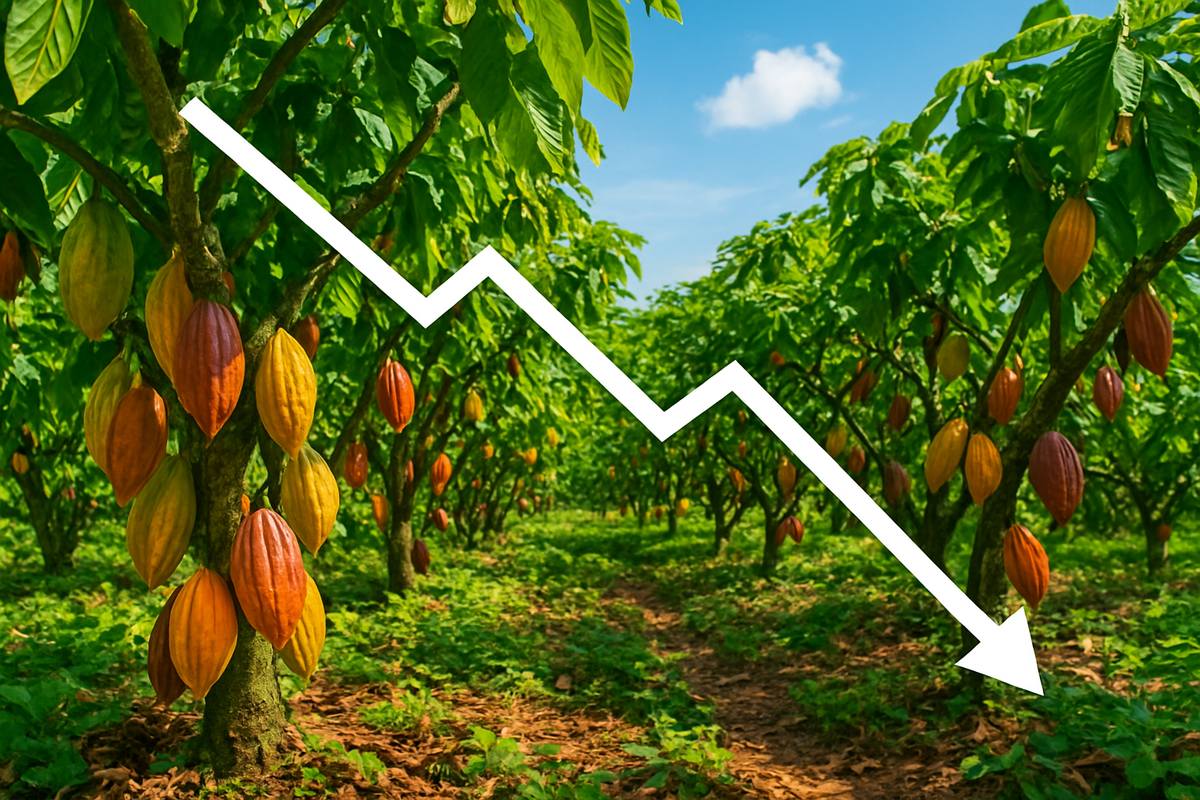
Cocoa prices have recently experienced a significant retreat, dropping below $6,200 per tonne around November 6, 2025, a welcome change from the record highs exceeding $12,900 per tonne witnessed in late 2024 and early 2025. This downturn, representing a 10-15% decrease from a year ago, is primarily driven by an improved supply outlook, particularly from the crucial West African growing regions. This shift has immediate and profound implications for chocolate manufacturers, potentially offering a much-needed reprieve from soaring input costs, and signals a broader recalibration within the soft commodities market.
Detailed Coverage: The Unwinding of a Cocoa Crisis
The dramatic surge in cocoa prices over the past year was largely fueled by successive poor harvests in West Africa, exacerbated by adverse weather conditions and disease. However, the narrative has begun to shift significantly around November 2025, as optimism surrounding a stronger West African cocoa crop takes hold. Farmers in Ivory Coast, the world's largest producer, are reporting thriving trees and favorable dry weather conditions conducive to bean drying, while Ghanaian farmers observe well-maturing pods. This positive sentiment is further bolstered by chocolate giant Mondelez (NASDAQ: MDLZ), which indicated that the latest cocoa pod count in West Africa is approximately 7% above the five-year average and "materially higher" than last year's crop.
The critical main-crop harvest in Ivory Coast has just commenced, with early reports suggesting producers are optimistic about the quality and quantity of the yield. This improved outlook is a stark contrast to the severe deficits of previous seasons. The International Cocoa Organization (ICCO) has reinforced this positive sentiment, forecasting a global cocoa surplus of 142,000 metric tonnes (MT) for the 2024/25 season. This projection marks the first surplus in four years, following a substantial deficit of 494,000 MT in the 2023/24 season, representing a significant turnaround. Overall global cocoa production is expected to increase by 7.8% year-on-year to 4.84 MMT for 2024/25, driven by improved weather and expanding production in regions like Ecuador.
Adding to the supply-side improvements, governments in key producing nations such as Ivory Coast and Ghana have raised farmgate prices. This strategic move aims to incentivize farmers, potentially boosting cocoa deliveries and ensuring a more stable supply chain in the long run. Initial market reactions to the price retreat have been a mix of relief and caution. While the immediate pressure on raw material costs has eased, the market remains wary of lingering volatility and the long-term structural challenges facing cocoa production.
However, it's not solely about supply; weakening demand has also played a role in the price correction. Major chocolate producer Barry Callebaut (SIX: BARN) anticipates a mid-single-digit drop in cocoa product sales in the upcoming fiscal year, attributing this to historically elevated prices leading to "demand destruction." Data supports this, with European cocoa grindings declining by 4.8% year-on-year in Q3 2025, reaching a 10-year low, and Q3 Asia grindings also seeing a significant fall. In North America, chocolate candy sales volumes were down over 21% in the 13 weeks ending September 7, underscoring how high prices have curbed consumer appetite.
Corporate Fortunes: Winners and Losers in the Cocoa Reversal
The retreat in cocoa prices offers a much-needed reprieve for chocolate manufacturers, who have been grappling with unprecedented raw material costs. Companies like Hershey (NYSE: HSY), Mondelez (NASDAQ: MDLZ), and Nestlé (SIX: NESN) are poised to be significant beneficiaries. Lower cocoa input costs are expected to alleviate pressure to raise retail prices further and could lead to improved gross margins. Hershey's CFO has already expressed hope for some deflation deeper into 2026, signaling cautious optimism within the industry. While these companies still need to work through existing high-cost inventories, the long-term outlook for profitability has brightened considerably.
Conversely, cocoa farmers, particularly those in West Africa, might face a mixed bag of outcomes. While governments have raised farmgate prices to incentivize production, a significant and sustained drop in global cocoa futures could eventually translate to lower earnings for farmers, especially if the current government-set prices are not fully insulated from market fluctuations. However, the improved crop yields themselves could offset some of the price declines by increasing overall volume of sales for farmers, provided the market remains robust enough to absorb the increased supply.
For cocoa processors, such as Barry Callebaut (SIX: BARN), the situation is nuanced. While lower raw material costs are generally favorable, the company has already projected a drop in sales volume due to the high retail prices that have curbed demand. This "demand destruction" means that even with cheaper cocoa, regaining lost sales volume might take time. The immediate benefit of lower input costs may be partially offset by the need to stimulate consumer demand through pricing adjustments or marketing efforts. Ingredient suppliers reliant on cocoa derivatives may also see their margins improve as their primary input becomes more affordable.
Ultimately, the shift favors the downstream players in the chocolate supply chain. Consumers, who have faced escalating chocolate prices, could eventually see some relief, although this typically lags behind raw material cost changes due to existing inventory cycles and manufacturing lead times. The improved supply outlook provides a crucial opportunity for the industry to stabilize, rebuild margins, and potentially innovate with more stable input costs.
Wider Significance: A Shift in the Soft Commodities Landscape
The recent retreat in cocoa prices is more than just a momentary blip; it signifies a broader recalibration within the soft commodities market, particularly after a period of extreme bullishness in late 2024 and early 2025. The "Soft Commodities Lose Their Sweetness" trend, observed across cocoa, coffee, and sugar markets in 2025, suggests an unwinding of speculative positions and a return to more fundamental supply-and-demand dynamics. This event highlights the inherent volatility and sensitivity of agricultural markets to weather patterns, geopolitical stability, and global demand shifts.
The ripple effects extend beyond cocoa. While other soft commodities like coffee and sugar have their own unique market drivers, a general easing of agricultural commodity prices could alleviate inflationary pressures on food manufacturers and consumers worldwide. This broader trend could impact investment flows, potentially shifting capital away from highly volatile agricultural futures towards more stable assets, or prompting a re-evaluation of risk within commodity portfolios. Furthermore, the focus on sustainable cocoa sourcing and fair trade practices might gain renewed attention as price pressures ease, allowing companies to prioritize long-term supply chain resilience over immediate cost containment.
Regulatory and policy implications could also emerge. The experience of extreme price volatility might prompt greater scrutiny from international bodies like the International Cocoa Organization (ICCO) regarding market transparency, price stabilization mechanisms, and support for cocoa-producing nations. There could be renewed calls for policies that protect farmers from severe price swings while ensuring stable supply for the global market. Historically, cocoa markets have been prone to boom-bust cycles, often driven by weather events, political instability in producing regions, and speculative trading. This current episode, while marked by an improved supply outlook, echoes past periods where supply shocks led to price spikes, followed by corrections as production recovered or demand waned.
Comparing this event to similar historical precedents, the rapid price surge and subsequent correction are characteristic of commodity markets where supply is concentrated in a few regions susceptible to environmental factors. The current situation, however, is notable for the swiftness of the projected supply recovery, which offers a glimmer of hope for a more balanced market in the near future, contrasting with longer, more protracted periods of scarcity seen historically.
What Comes Next: Navigating a More Balanced, Yet Volatile, Market
In the short term, the cocoa market is likely to remain dynamic. While the immediate supply outlook is positive, the industry will be closely watching the progress of the West African main crop harvest. Any unexpected weather events or logistical challenges could quickly reverse the current positive sentiment. Chocolate manufacturers will focus on managing existing high-cost inventories while strategically planning future purchases to capitalize on lower spot prices. Consumers, though not seeing immediate price drops, might benefit from price stability or even slight reductions in the medium term, as cheaper raw materials work their way through the supply chain.
Longer term, the cocoa market is expected to remain structurally higher than historical norms, even with the current retreat. Persistent productivity challenges in Ivory Coast and Ghana, coupled with ongoing climate risks suchating extreme weather events, suggest that the era of exceptionally cheap cocoa may be behind us. J.P. Morgan Global Research anticipates cocoa prices will hover around $6,000/tonne for longer, indicating a new baseline for the commodity. This necessitates strategic pivots for chocolate companies, focusing on supply chain diversification, investment in sustainable farming practices, and potentially exploring alternative ingredients or formulations to reduce reliance on cocoa.
Market opportunities may emerge for companies that can efficiently adapt to these new price realities. Those with strong hedging strategies or diversified sourcing could gain a competitive advantage. Furthermore, the inclusion of cocoa in the Bloomberg Commodity Index (BCOM) starting January 2026, after a two-decade absence, is a significant development. This is expected to trigger substantial inflows of approximately $1.9 billion in passive fund investments into cocoa futures over the subsequent 80 days. This influx could provide a floor for prices or even support future increases, adding another layer of complexity and potential volatility to the market. This scenario suggests that while fundamentals are improving, external investment flows could still exert upward pressure on prices.
Wrap-Up: A Cautious Optimism for the Cocoa Market
The recent retreat in cocoa prices, driven by an improved supply outlook from West Africa and softening global demand, marks a significant turning point for the soft commodities market. The key takeaway is a much-needed reprieve for chocolate manufacturers from the unprecedented raw material costs of the past year, offering the potential for margin recovery and a stabilization of retail prices. While the immediate future holds promise for a more balanced market, the long-term outlook suggests that cocoa prices may settle at a new, higher baseline compared to historical averages, influenced by ongoing climate challenges and structural production issues.
Moving forward, the market will be keenly assessing the actual yields from the West African harvest and the impact of the upcoming Bloomberg Commodity Index inclusion. Investors should watch for further data on grindings and chocolate sales to gauge the true extent of demand recovery. Any shifts in weather patterns in key growing regions will also be critical indicators. The cocoa market, while showing signs of easing, is far from stable and will continue to be a fascinating, albeit volatile, space for both producers and consumers in the coming months. The journey from crisis highs to a more sustainable equilibrium will be closely monitored by all stakeholders across the global chocolate industry.





